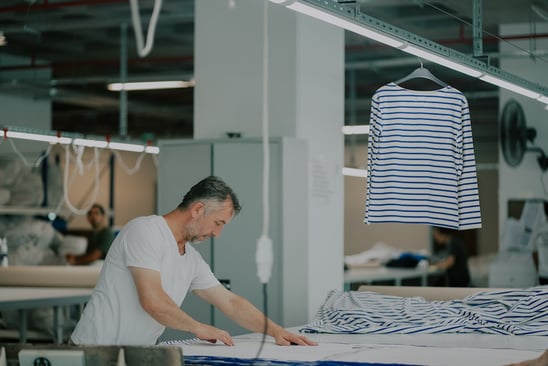Fashion Resale Market: Trends, Growth, and the Future of Sustainable Retail

Did you expect shoulder pads to come back in style? What about the iconic Juicy Couture tracksuit of the early aughts?
Certain fashion trends are often associated with the past (and sometimes you might wish they’d stay there), but they have a way of resurfacing. Fashion trends coming back in vogue are especially prevalent with the rise in the popularity of fashion resale.
Fashion resale, that is, is the practice of reselling secondhand or vintage clothing.
Rather than reinvent the wheel and purchase brand-new iterations of past trends, many consumers are thrifting for the originals, raiding their family member’s closets for hidden treasures, or buying them online. Some are even turning to small businesses to do the thrifting for them.
There’s a clear demand for pre-loved and secondhand clothing. Globally, the secondhand market is estimated to reach $351 billion by 2027 (Statista), and the U.S. fashion resale market alone is projected to hit $23.92 billion in 2026 (Insider Intelligence).
Want to capitalize on the secondhand market but don’t know how? Here’s a breakdown of what fashion resale is and how you can make it part of your ecommerce strategy.
Why Are Shoppers Interested in the Fashion Resale Market?
There are three standout reasons why the resale market has had a rise in popularity: sustainability, identity, and price point.
Sustainability in the Fashion Resale Market
There’s a sustainability element to the popularity of resale fashion: It appeals to shoppers — millennials and Gen Zers in particular — who care about slow fashion and the environment.
According to Salsify’s “2022 Consumer Research” report, global consumers are taking sustainability seriously in their shopping habits: British (31%), U.S. (33%), French (44%), and German (53%) shoppers check product packaging and recycling information before making purchases.
Environmentally conscious consumers also take the following factors into consideration:
- Third-party sustainability certifications;
- Ingredient sourcing;
- Carbon footprint; and
- A company’s environmental policies, hiring, wages, fair labor practices, and reputation.
Ninety percent of survey respondents in eBay’s “Recommerce Report 2022” say that reducing waste is a critical part of engaging in recommerce. Millennials (39%) and Gen Zers (36%) also place a high value on sustainability in their secondhand shopping efforts.
Secondhand Shopping as an Identity
In an interview with NPR, Juliette Le Zotte, author of “From Goodwill to Grunge” and historian, says that teenagers have historically driven the sales of secondhand clothes in an attempt to set themselves apart from previous generations and create new trends with their peers.
Buying secondhand clothing allows shoppers to curate their style and share it with others. Many secondhand shoppers turn to TikTok or other social media platforms to do a clothing haul for their viewers. These hauls promote their unique sense of fashion while also reinforcing their beliefs about sustainability.
It’s also just plain fun: Statista notes that more than one-third of shoppers are after the thrill of the hunt. Depop seller Eve Perez tells NPR, “Younger people find it fun, like a game. A hunt for something unique."
@jbwells2 everything i don’t keep will be on depop friday at 7pm EST 🫶🏻
♬ original sound - Jack
Video Source: jbwells2 TikTok
The Secondhand Price Tag
The price point also plays a factor in consumers’ willingness to purchase secondhand. Statista cites affordability as a major driver of secondhand clothing demand worldwide.
Resale fashion is (typically) a cheaper option than purchasing brand new. Clothing that would be inaccessible to younger buyers is made accessible through secondhand fashion. If an item is particularly sought after, however, there may be a higher price tag.
Vintage and pre-loved luxury goods have also become more accessible to consumers through online marketplaces like The Real Real that authenticate each item. Customers also have more access to more unique, hard-to-find luxury items, reports McKinsey & Company.
McKinsey & Company survey respondents give the following reasons for buying luxury secondhand:
- Buying pre-owned increases their likelihood of owning hard-to-find, unique items (41%).
- It’s more sustainable (40%).
- Secondhand luxury is more affordable (36%).
- It’s easier for them to buy secondhand instead of buying brand new (25%).
- There’s no waitlist, and delivery time is faster (25%).
Popular Fashion Resale Trends for Brands
These global demands have caused brands to get creative with their reselling tactics.
For example, the online publication Glossy reports that brands are turning to resale as a holiday ecommerce strategy. By reselling products, brands can lower prices without negatively impacting profit margins.
Other popular resale fashion trends include:
- Giving shoppers store credit for pre-worn clothing trade-ins;
- Reselling products on a dedicated section of a brand’s website; and
- Refurbishing products.
The below three brands have masterfully implemented these strategies.
3 Brands Successfully Executing Fashion Resale
Reselling fashion looks different for each brand depending on its products and ethos. Here are three brands that are expertly executing their operations.
1. Levi’s Knows Its Denim Audience
Clothing company Levi’s, known for its denim jeans, spearheads a program called Levi’s SecondHand that encourages users to purchase vintage Levi’s that are resold on its website.
Secondhand shoppers often refer to vintage Levi’s as a staple in their wardrobe, particularly highlighting Levi’s 501 jeans. The brand’s SecondHand page caters to this market with an entire section dedicated to its 501 collection. Image Source: Levi’s
For the Y2K lovers (which is now considered vintage), Levi’s has an Early 2000s collection, amongst a number of other collections like Made in the USA, Vintage, and Vintage Shorts. The brand also provides a sizing guide to help ensure the right fit.
Shoppers have the option of trading in their pre-worn denim for a gift card that matches the value of their trade-in.
Image Source: Levi’s
Similar to Levi’s, clothing brand Madewell offers a denim recycling program that entices consumers to drop off their well-worn denim for $20 off a new pair of jeans. The recycled jeans are turned into insulation for a house. While this isn’t part of a resale program, it’s an excellent example of sustainability practices.
2. The North Face Revives Old Gear
Outdoor recreational clothing and gear brand The North Face engages in a buy-back and resale business model with its Renewed Take-Back program.
The Renewed Take-Back program encourages customers to bring in their old gear for $10 off their next purchase. The gear will be refurbished and sold, but if it can’t be repaired, The North Face will donate or recycle the gear for the customer.
Shoppers can purchase refurbished, like-new gear at a discounted rate, or they can purchase reconditioned gear that has visible small repairs for up to 60% off. There are eight steps and six quality checks involved in The North Face’s refurbishment process.
- Pre-Sort: Products are sorted into renewal and recycle piles. Anything that can’t be used is donated or recycled.
- Sort: Products are inspected for issues and prepared to be refurbished.
- Identify: Products are checked for known quality issues and barcodes are added.
- Clean: Gear is cleaned to match factory-grade standards.
- Inspect: Repair technicians decide what will be returned to like-new condition.
- Repair: Sewing technicians repair gear based on The North Face’s quality standards.
- Finishing Touches: Loose threads, lint, and wrinkles are taken care of and removed.
- Quality Assurance: The North Face’s QA team certifies every Renewed garment. The company offers free returns and one-year warranty.
By ensuring that each renewed piece offers the expected quality of The North Face, the brand guarantees that its customers will walk away satisfied every time.
3. Lululemon Like New
Lululemon Like New offers a similar trade-in program that gives customers store credit for their used gear. But the athletic clothing company takes it one step further and donates 100% of its Like New profits to the Apparel Impact Institute's Fashion Climate Fund, which is dedicated to removing up to “150 million tonnes of CO2 from the apparel supply chain.”
Shoppers can also purchase popular items for a big slash in price. Like The North Face, Lulelmon Like New has two categories: good as new and gently used. Good as new means that you can expect the same quality of clothing as a brand-new item, and gently used means that there might be minimal signs of wear.
The refurbished clothing categories run the gamut from pants and shirts to purses, shoes, and sports bras, all with an inclusive size range.
Shoppers can also enjoy free shipping on all orders over $125. It’s certainly an enticing program for athleisure lovers.
Image Source: Lululemon Like New
How Can You Capitalize on Resale Fashion?
McKinsey & Company reports that “entry of brands into the resale market has a positive impact on loyalty and desirability among new-product buyers.”
If you want to achieve this level of loyalty and desirability, consider your sustainability goals and how resale fashion would help you achieve them.
Ask yourself:
- Are you able to refurbish your products?
- How would you implement resale fashion into your ecommerce strategy?
- What operating method will you use (peer-to-peer, buyback, third party, etc.)?
- How would participating consumers benefit?
If you don’t participate, you’ll still see your products resold on other platforms. Creating your own program will give you more control over how your products are sold, so it’s worth consideration.
Don’t Miss Out on the Future of Resale Fashion
According to Quartz, a global, economic-focused outlet, the secondhand clothing market might outpace the growth of fast fashion as more and more people catch on to the environmental, social, and economic benefits of sustainable fashion.
Creating a fashion resale program will make your clothing accessible to a new audience, reinforce your stance on sustainability, improve your profit margins, and more. Don’t miss out on this opportunity to join one of the fastest-growing markets in the world.

How To Break Down Commerce Barriers and Convert More Customers
Download this report to learn how brands and retailers can collaborate to better enable sales growth and customer satisfaction.
DOWNLOAD REPORTWritten by: Madeline (Koufogazos) Marasco
Madeline (Koufogazos) Marasco (she/her) is an editor and writer at Salsify, based out of Boston. She enjoys sharing her insights on consumer trends and behaviors, commerce, media, pop culture, and travel.
Recent Posts
The State of Secondhand Shopping: Circular Commerce Trends and Consumer Insights
How To Kick Shopping Cart Abandonment to the Curb
Gen Alpha Trends: How the Next Generation Influences Buying Behavior and Decisions
Subscribe to the Below the Fold Newsletter
Standing out on the digital shelf starts with access to the latest industry content. Subscribe to Below the Fold, our monthly content newsletter, and join other commerce leaders.

.svg)